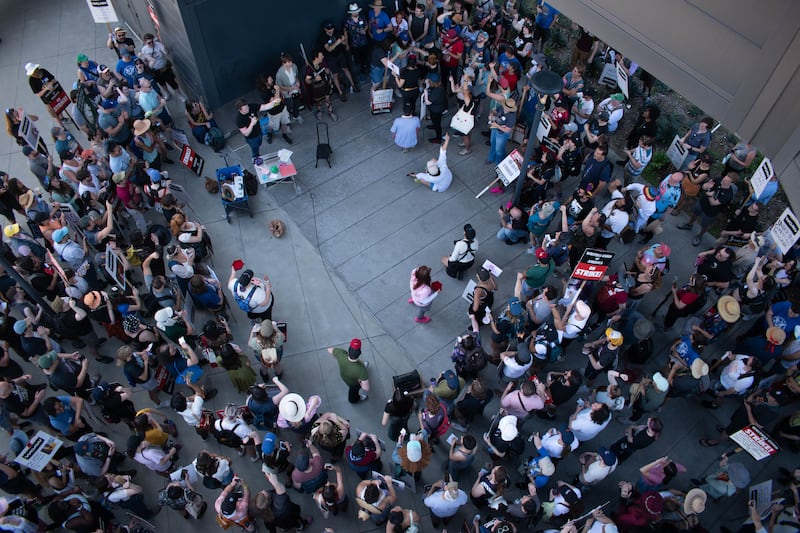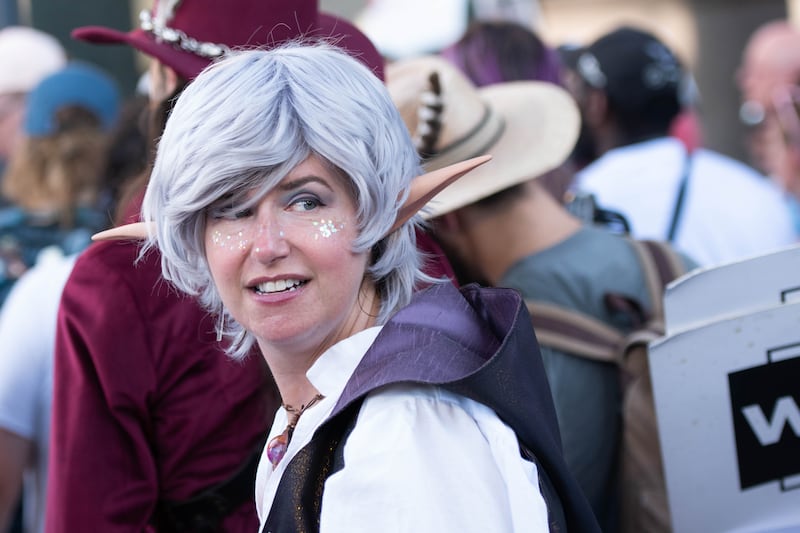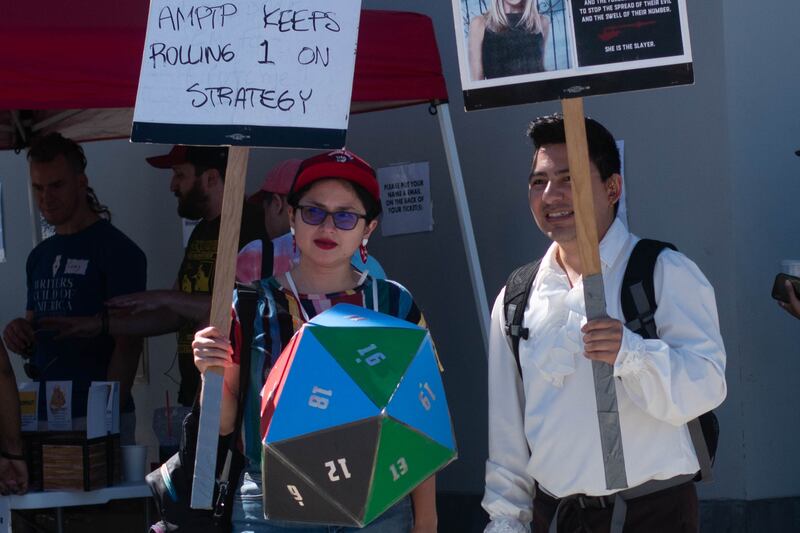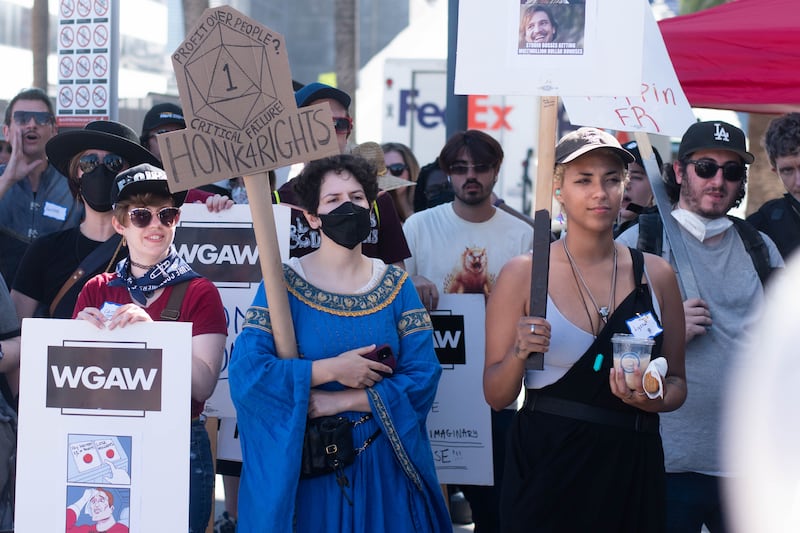
A crowd of wizards, bards, druids and elves gather outside of NBC Universal. They are thirsty — for provisions, loot… and blood. A red-haired Dungeon Master (DM) looks over a die. He turns to the crowd, grinning. “D20!”
The crowd breaks into joy, clamoring their weapons, signs and fists in the air.
The DM recounts the party’s next move as the crowd quiets down.
“The rogue in your party surges forward, thrusting his magical short sword in the air. We see the damage that the CEO of NBC Universal is about to take!”
The crowd screams: vindication.

Brennan Lee Mulligan, the DM, begins to narrate the rest of the battle.
He’s goading on hundreds of writers, actors and supporters— players of the ongoing, high-stakes, industry quest: the WGA and SAG-AFTRA strike.

Today, at NBC Universal, it’s D&D on the picket line.


Konstantine Anthony, the Mayor of Burbank, is in the crowd, too. He’s dressed like a Roman gladiator. Like Spartacus before him, Anthony sees the value of strength in numbers as a technique to fight the common enemy.

“What we’re seeing today against corporate America is that small, disparate groups of working class citizens are having to band together,” said Anthony, who is also a member of SAG-AFTRA. “And it is exactly mirrored in the quests and campaigns that we’ve seen in Dungeons and Dragons… because what we write about in our art, in our media and in our gaming is true to life.”
Kirk Damato, a writer dressed like a wizard, continued the metaphor. “I think [this strike] would be called a campaign, which is a long-running collection of adventures, like a season of television. We’re in an extended campaign. I think of this a lot like a siege. We are literally at the studios, where you can hear the horns honking and people cheering in the background, people with the signs trying to get the message across both to the public, and to any executive who might be able to hear it.”


On the Universal line, strikers have faced both hardship and difficult terrain. Universal was voted “the worst picket” according to strikers, due to extensive construction and road work debris; “treegate,” when the studio illegally cut down tree branches that provided shade for the picket line; intense parking enforcement; and the presence of a heat-intensive flamethrower at a nearby construction site.
In spite of these obstacles, the movement’s momentum has continued to grow. Just this week, Disney’s visual effects workers publicly filed to unionize with IATSE, the International Alliance of Theatrical Stage Employees, which represents many behind-the-scenes entertainment workers. Beyond the entertainment industry, this summer, UPS teamsters and airline pilots negotiated significant raises; Los Angeles city workers hosted a day-long strike in August; hotel workers have been on strike since July; and efforts to unionize within companies Starbucks and Delta are ongoing.

“It is spreading. It seems like it’s catching,” Damato says. “We are leveling up. I mean, look at this party. It’s grown…We’re building a bigger community, which is amazing.”
Theme days, like Wednesday’s Dungeons and Dragons demonstration, have been a key strategy in keeping morale high on the WGA/SAG-AFTRA picket lines. Examples of past theme days include: “Bridgerton,” “Family Guy,” “The OC,” Late Night writers, Black filmmakers, LGBTQ+ writers and even introvert-only morning pickets.
“I’ve lost track of all my costumes,” says Montserrat Luna-Ballantyne, a WGA writer. “I’ve done Taylor Swift, I’ve done Britney Spears’s ‘Toxic’ flight attendant suit and Megan’s dress, from the horror movie ‘Megan’. Today, I’m a D20 dice.”

Writers, actors and supporters have had the opportunity to come together, analyze difficult aspects of their careers and find similarities in their plights at the picket lines. This has resulted in increased solidarity and an ongoing determination to win fair wages and workers’ rights.
“The working class has much solidarity [because] we’re just scraping by, and we’re all in this together. That’s the only way we can get through this.” Luna-Ballantyne explains. “The struggles you’re seeing in this industry are seen in other industries across the board.”
Strikers continue to see this fight as a boon of what’s to come for the American labor movement — they largely believe that their win (or loss) will set a public precedent.
“We’ve seen how the AMPTP is willing to put money towards a [crisis PR firm],” said Rachel SJ, a SAG-eligible actor. “But, they don’t want to give us a fair contract. Because if they give one union a fair contract, it sets a standard for everybody else.”

In order to maintain the long-term nature of the strike, picket days during the summer heat waves have been cut to just 9 a.m. to 12 p.m. Initially, when the strike began in May, pickets ended around 5 p.m.
“It’s turned into more of a day-to-day occupation. We come in, we strike, we picket. We do our work and go home. It’s almost a job for us,” said Cheech Manohar, a member of SAG and WGA.
Along with entertaining theme days, picket lines provide sunscreen, hydration and snacks. Strike captains encourage people to take breaks in order to avoid heat stroke. Many strikers consider this effort “a marathon, not a sprint.”

In order to survive the financial hardship of being without work, strikers have been supported by the Entertainment Community Fund and the Green Envelope Grocery fund, both of which accept donations. A number of businesses, bars, churches and community groups have also offered mutual aid distributions, specifically for industry workers.
Special pickets and rallies are open to the public. For more information, the list of future special pickets is available on the WGA website.